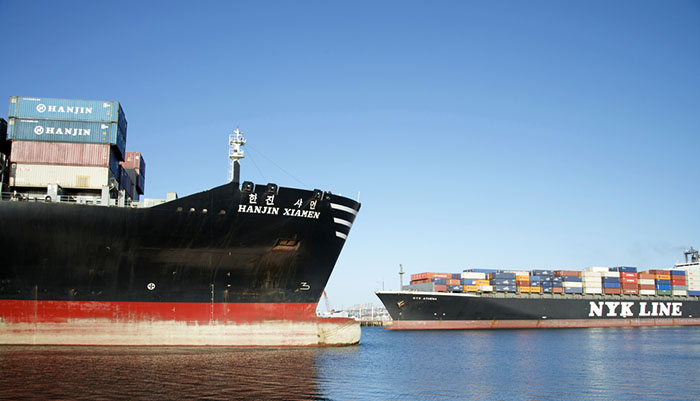Others could follow Hanjin before container shipping rebound
Hugh R. Morley, Senior Editor | Sep 13, 2016 4:08PM EDT
 The collapse of Hanjin Shipping won't fix the most pressing issue facing container lines: overcapacity.
The collapse of Hanjin Shipping won't fix the most pressing issue facing container lines: overcapacity.
NEW YORK — Container shipping overcapacity that pushed Hanjin Shipping into bankruptcy protection will likely claim another carrier before the market rebounds, industry executives said at a major shipping conference in New York Tuesday. The executives added that market improvement could be a year away.
Although spot rates on some routes have increased in the wake of the Hanjin collapse, that likely will only be temporary until the peak season is over. A permanent uptick will require changes in the supply of container ships, which likely won’t occur even if the ocean carrier goes into liquidation, said speakers on a panel about container ships and liners at the Capital Link New York Maritime Forum.
Peter Schaerf, vice chairman of Seaspan, an owner and manager of container ships, asked if there is “any other shoe about to drop.” He said his company and others are “more alert to greater counterparty risk” as a result of the Hanjin collapse.
“I am sure there are other shoes to drop — and let’s not name names here,” Schaerf told the audience of about 100 people.
That statement was echoed by Howard Finkel, executive vice president of China Cosco Shipping Americas.
“I don’t think we are out of trouble here,” he said, adding that two months before Hanjin’s move into bankruptcy he “started getting a lot of requests from very major importers, basically saying ‘What are you going to do if one of your alliance partners’ ships gets arrested?’”
"So this is on the radar of everybody,” Finkel said. “We are not out of the woods yet here. I don’t want to talk about what’s going to happen with Hanjin, but it does not look very good right now and there are other companies in financial distress.”
Finkel called the Hanjin collapse a potential “wake-up call for the industry.” He said that as a member of the CKYHE Alliance, along with Hanjin, “K” Line, Yang Ming Line, and Evergreen Line, his company is burdened with the difficulty of getting Cosco containers off Hanjin vessels and unloaded Hanjin containers from Cosco ships into ports that don’t want to accept them.
“I really feel this situation with Hanjin is such a game changer,” Finkel said. “We have had companies go out of business before. But not to this extent."
He said the “realities of the market” and the impact of the Hanjin collapse would inject change into the industry, but it wouldn’t bring shipping rates up enough for carriers to make money for at least a year.
“But I think it’s going in the right direction,” he said. “Shippers, I think, are going to get the message that we cannot continue to operate at non-compensatory levels.”
Although spot rates will go up, and will do so until Christmas, there won’t be any meaningful change for a while in contract rates, which show few signs of increasing, he said. Trans-Pacific service contracts for the season that runs from May 1, 2016, through April 30, 2017, dropped below $750 per 40-foot-equivalent unit to the West Coast and $1,500 per FEU to the East Coast, according to informal discussions with carriers and beneficial cargo owners. Historically, contract rates were in the range of $1,800 to $2,000 per FEU to the West Coast and about $3,000 on all-water services to the East Coast.
“The (spot) rates are going up, but it’s tempered by the BCO contracts compared to the spot market,” he said.
Schaerf said the spot rate increases, if demand continues to rise, will help temporarily “turn red lines into black lines by the end of the year. There is enough spot cargo for those (carriers) that are unprofitable to become profitable.”
Spot freight rates from Asia to the United States held after a surge last week, according to the most recent reading of the Shanghai Shipping Exchange, as displayed on JOC.com’s Market Data Hub. But the failure to rise above $1,749 per 20-foot equivalent unit from Asia to the US West Coast suggests importers are finding space on other carriers during the peak season despite the loss of Hanjin capacity. Similarly, Asia-Europe spot rates slipped last week after surging 40 percent on the immediate loss of Hanjin capacity.
Schaerf said customers he has spoken to have a “wait-and-see” attitude as to how the Hanjin situation plays out, and the long-term impact. Schaerf said his expectation is that Hanjin will not emerge from bankruptcy, but will instead liquidate.
If that happens, “it hasn’t fixed the supply problem,” he said, because the about 95 ships operated by Hanjin, about 60 chartered and the remainder owned by the carrier, will simply be sold and brought back into the market, he said.
“I would argue that Hanjin is only a game changer if ships become scrapped,” Schaerf said. “Because it’s not taking out supply out of the market. Until that happens — it could serve as a wake-up call, but rates have to come up to allow volumes to sustain themselves,” and the carriers have to order no more new ships, he added.

No comments:
Post a Comment